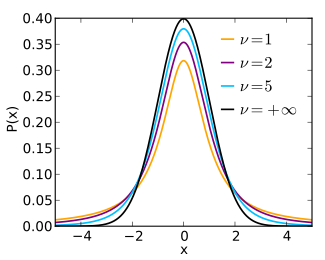
Student's t-distribution

In probability and statistics, Student's t-distribution (or simply the t-distribution) is any member of a family of continuous probability distributions that arises when estimating the mean of a normally distributed population in situations where the sample size is small and population standard deviation is unknown. It was developed by William Sealy Gosset under the pseudonym Student. In probability and statistics, Student's t-distribution (or simply the t-distribution) is any member of a family of continuous probability distributions that arises when estimating the mean of a normally distributed population in situations where the sample size is small and population standard deviation is unknown. It was developed by William Sealy Gosset under the pseudonym Student. The t-distribution plays a role in a number of widely used statistical analyses, including Student's t-test for assessing the statistical significance of the difference between two sample means, the construction of confidence intervals for the difference between two population means, and in linear regression analysis. The Student's t-distribution also arises in the Bayesian analysis of data from a normal family. If we take a sample of n observations from a normal distribution, then the t-distribution with ν = n − 1 {displaystyle u =n-1} degrees of freedom can be defined as the distribution of the location of the sample mean relative to the true mean, divided by the sample standard deviation, after multiplying by the standardizing term n {displaystyle {sqrt {n}}} . In this way, the t-distribution can be used to construct a confidence interval for the true mean. The t-distribution is symmetric and bell-shaped, like the normal distribution, but has heavier tails, meaning that it is more prone to producing values that fall far from its mean. This makes it useful for understanding the statistical behavior of certain types of ratios of random quantities, in which variation in the denominator is amplified and may produce outlying values when the denominator of the ratio falls close to zero. The Student's t-distribution is a special case of the generalised hyperbolic distribution. In statistics, the t-distribution was first derived as a posterior distribution in 1876 by Helmert and Lüroth. The t-distribution also appeared in a more general form as Pearson Type IV distribution in Karl Pearson's 1895 paper. In the English-language literature the distribution takes its name from William Sealy Gosset's 1908 paper in Biometrika under the pseudonym 'Student'. Gosset worked at the Guinness Brewery in Dublin, Ireland, and was interested in the problems of small samples – for example, the chemical properties of barley where sample sizes might be as few as 3. One version of the origin of the pseudonym is that Gosset's employer preferred staff to use pen names when publishing scientific papers instead of their real name, so he used the name 'Student' to hide his identity. Another version is that Guinness did not want their competitors to know that they were using the t-test to determine the quality of raw material. Gosset's paper refers to the distribution as the 'frequency distribution of standard deviations of samples drawn from a normal population'. It became well-known through the work of Ronald Fisher, who called the distribution 'Student's distribution' and represented the test value with the letter t. Let X 1 , … , X n { extstyle X_{1},ldots ,X_{n}} be independent and identically distributed as N ( μ , σ 2 ) {displaystyle N(mu ,sigma ^{2})} , i.e. this is a sample of size n {displaystyle n} from a normally distributed population with expected mean value μ {displaystyle mu } and variance σ 2 {displaystyle sigma ^{2}} .
